Investigation of Mass-Transfer Performance for Biodiesel Reaction in Microchannel Reactor using Volume-of-Fluid with Species-Transport Model
Abstract
:1. Introduction
2. Materials and Methods
2.1. Experimental Setup
2.2. Simulation Setup and Boundary Conditions
3. Results and Discussion
3.1. Slug Formation
3.2. Concentration Contour Plot due to Mass Transfer
3.3. Effect of Velocity on Mass Transfer during Forming and Moving Stages
3.4. Effect of Flow Rate on Transesterification Reaction
4. Conclusions
Author Contributions
Funding
Institutional Review Board Statement
Informed Consent Statement
Data Availability Statement
Acknowledgments
Conflicts of Interest
References
- Yue, J. Multiphase Flow Processing in Microreactors Combined with Heterogeneous Catalysis for Efficient and Sustainable Chemical Synthesis. Catal. Today 2018, 308, 3–19. [Google Scholar] [CrossRef]
- Atobe, M.; Tateno, H.; Matsumura, Y. Applications of Flow Microreactors in Electrosynthetic Processes. Chem. Rev. 2018, 118, 4541–4572. [Google Scholar] [CrossRef] [PubMed]
- Chamkha, A.J.; Molana, M.; Rahnama, A.; Ghadami, F. On the Nanofluids Applications in Microchannels: A Comprehensive Review. Powder Technol. 2018, 332, 287–322. [Google Scholar] [CrossRef]
- Olanrewaju, A.; Beaugrand, M.; Yafia, M.; Juncker, D. Capillary Microfluidics in Microchannels: From Microfluidic Networks to Capillaric Circuits. Lab Chip 2018, 18, 2323–2347. [Google Scholar] [CrossRef] [PubMed] [Green Version]
- Suryawanshi, P.L.; Gumfekar, S.P.; Bhanvase, B.A.; Sonawane, S.H.; Pimplapure, M.S. A Review on Microreactors: Reactor Fabrication, Design, and Cutting-Edge Applications. Chem. Eng. Sci. 2018, 189, 431–448. [Google Scholar] [CrossRef]
- Wei, L.; Yu, C.; Zhang, Q.; Liu, H.; Wang, Y. TiO2-Based Heterojunction Photocatalysts for Photocatalytic Reduction of CO2 into Solar Fuels. J. Mater. Chem. Mater. 2018, 6, 22411–22436. [Google Scholar] [CrossRef]
- Shi, H.; Nie, K.; Dong, B.; Long, M.; Xu, H.; Liu, Z. Recent Progress of Microfluidic Reactors for Biomedical Applications. Chem. Eng. J. 2019, 361, 635–650. [Google Scholar] [CrossRef]
- Mohd Laziz, A.; KuShaari, K.; Azeem, B.; Yusup, S.; Chin, J.; Denecke, J. Rapid Production of Biodiesel in a Microchannel Reactor at Room Temperature by Enhancement of Mixing Behaviour in Methanol Phase Using Volume of Fluid Model. Chem. Eng. Sci. 2020, 219, 115532. [Google Scholar] [CrossRef]
- Miyuranga, K.A.V.; Balasuriya, B.M.C.M.; Arachchige, U.S.P.R.; Jayasinghe, R.A.; Weerasekara, N.A. Comparison of Performance of Various Homogeneous Alkali Catalysts in Transesterification of Waste Cooking Oil. Asian J. Chem. 2022, 34, 3157–3161. [Google Scholar] [CrossRef]
- Pang, L.; Lv, S.; Li, K.; Ding, L.; Hao, Y. Parameter Optimization for the Biodiesel of Xanthoceras Sorbifolium Oil and Determination of Fatty Acid Methyl Ester. Bioresources 2022, 18, 844–854. [Google Scholar] [CrossRef]
- Chimezie, E.C.; Wang, Z.; Yu, Y.; Nonso, U.C.; Duan, P.-G.; Kapusta, K. Yield Optimization and Fuel Properties Evaluation of the Biodiesel Derived from Avocado Pear Waste. Ind. Crops Prod. 2023, 191, 115884. [Google Scholar] [CrossRef]
- Yusuff, A.S.; Tanko, N.L.; Azeez, T.M.; Obende, B.A. Methanolysis of Fresh and Used Soybean Oil to Biodiesel under Mild Conditions: Process Optimization, Fuel Quality Characterization and Thermal Stability Studies. Chem. Eng. Process.-Process Intensif. 2022, 182, 109177. [Google Scholar] [CrossRef]
- Sundaramahalingam, M.A.; Karthikumar, S.; Shyam Kumar, R.; Samuel, K.J.; Shajahan, S.; Sivasubramanian, V.; Sivashanmugam, P.; Varalakshmi, P.; Syed, A.; Marraiki, N.; et al. An Intensified Approach for Transesterification of Biodiesel from Annona Squamosa Seed Oil Using Ultrasound-Assisted Homogeneous Catalysis Reaction and Its Process Optimization. Fuel 2021, 291, 120195. [Google Scholar] [CrossRef]
- Abdulla Yusuf, H.; Hossain, S.M.Z.; Aloraibi, S.; Alzaabi, N.J.; Alfayhani, M.A.; Almedfaie, H.J. Fabrication of Novel Microreactors In-House and Their Performance Analysis via Continuous Production of Biodiesel. Chem. Eng. Process.-Process Intensif. 2022, 172, 108792. [Google Scholar] [CrossRef]
- Veluturla, S.; Rambhia, S.A.; Pranavi, S. Process Intensification Studies in Synthesis of Biodiesel with a Helical Coil Continuous Microreactor. Biofuels 2022, 14, 387–392. [Google Scholar] [CrossRef]
- Aghel, B.; Mohadesi, M.; Razmehgir, M.H.; Gouran, A. Biodiesel Production from Waste Cooking Oil in a Micro-Sized Reactor in the Presence of Cow Bone-Based KOH Catalyst. Biomass Convers. Biorefin. 2022. epub ahead of print. [Google Scholar] [CrossRef]
- Shrimal, P.; Sanklecha, H.; Patil, P.; Mujumdar, A.; Naik, J. Biodiesel Production in Tubular Microreactor: Optimization by Response Surface Methodology. Arab. J. Sci. Eng. 2018, 43, 6133–6141. [Google Scholar] [CrossRef]
- Gopi, R.; Thangarasu, V.; Vinayakaselvi, M.A.; Ramanathan, A. A Critical Review of Recent Advancements in Continuous Flow Reactors and Prominent Integrated Microreactors for Biodiesel Production. Renew. Sustain. Energy Rev. 2022, 154, 111869. [Google Scholar] [CrossRef]
- Csernica, S.N. The Phase Behavior Effect on the Reaction Engineering of Transesterifcation Reactions and Reactor Design for Continuous Biodiesel Production; Lehigh University: Bethlehem, PA, USA, 2013. [Google Scholar]
- Sattari-Najafabadi, M.; Nasr Esfahany, M.; Wu, Z.; Sundén, B. Hydrodynamics and Mass Transfer in Liquid-Liquid Non-Circular Microchannels: Comparison of Two Aspect Ratios and Three Junction Structures. Chem. Eng. J. 2017, 322, 328–338. [Google Scholar] [CrossRef]
- Yang, L.; Nieves-Remacha, M.J.; Jensen, K.F. Simulations and Analysis of Multiphase Transport and Reaction in Segmented Flow Microreactors. Chem. Eng. Sci. 2017, 169, 106–116. [Google Scholar] [CrossRef]
- Bai, L.; Zhao, S.; Fu, Y.; Cheng, Y. Experimental Study of Mass Transfer in Water/Ionic Liquid Microdroplet Systems Using Micro-LIF Technique. Chem. Eng. J. 2016, 298, 281–290. [Google Scholar] [CrossRef]
- Xu, J.H.; Tan, J.; Li, S.W.; Luo, G.S. Enhancement of Mass Transfer Performance of Liquid–Liquid System by Droplet Flow in Microchannels. Chem. Eng. J. 2008, 141, 242–249. [Google Scholar] [CrossRef]
- Kushaari, K.; Laziz, A.M.; Hamid, N.H. Quantitative Analysis of Interfacial Area on Liquid-Liquid Multiphase Flow of Transesterification Process in Cross-Junction Microchannel Reactor. J. Eng. Technol. Sci. 2019, 51, 585–596. [Google Scholar] [CrossRef] [Green Version]
- ANSYS Inc. Ansys Fluent 2022 R2 Theory Guide; ANSYS Inc.: Canonsburg, PA, USA, 2022. [Google Scholar]
- Mac Giolla Eain, M.; Egan, V.; Punch, J. Film Thickness Measurements in Liquid–Liquid Slug Flow Regimes. Int. J. Heat Fluid Flow 2013, 44, 515–523. [Google Scholar] [CrossRef] [Green Version]
- Aussillous, P.; Quéré, D. Quick Deposition of a Fluid on the Wall of a Tube. Phys. Fluids 2000, 12, 2367. [Google Scholar] [CrossRef]
- Fairbrother, F.; Stubbs, A.E. 119. Studies in Electro-Endosmosis. Part VI. The “Bubble-Tube” Method of Measurement. J. Chem. Soc. 1935, 1, 527–529. [Google Scholar] [CrossRef]
- Bretherton, F.P. The Motion of Long Bubbles in Tubes. J. Fluid Mech. 1961, 10, 166–188. [Google Scholar] [CrossRef]
- Han, Y.; Shikazono, N. Measurement of the Liquid Film Thickness in Micro Tube Slug Flow. Int. J. Heat Fluid Flow 2009, 30, 842–853. [Google Scholar] [CrossRef]
- Mohd Laziz, A.; KuShaari, K.; Chin, J.; Denecke, J. Quantitative Analysis of Hydrodynamic Effect on Transesterification Process in T-Junction Microchannel Reactor System. Chem. Eng. Process.-Process Intensif. 2019, 140, 91–99. [Google Scholar] [CrossRef]
- Biswas, K.G.; Das, G.; Ray, S.; Basu, J.K. Mass Transfer Characteristics of Liquid–Liquid Flow in Small Diameter Conduits. Chem. Eng. Sci. 2015, 122, 652–661. [Google Scholar] [CrossRef]
- Ghaini, A.; Kashid, M.N.; Agar, D.W. Effective Interfacial Area for Mass Transfer in the Liquid–Liquid Slug Flow Capillary Microreactors. Chem. Eng. Process. Process Intensif. 2010, 49, 358–366. [Google Scholar] [CrossRef]
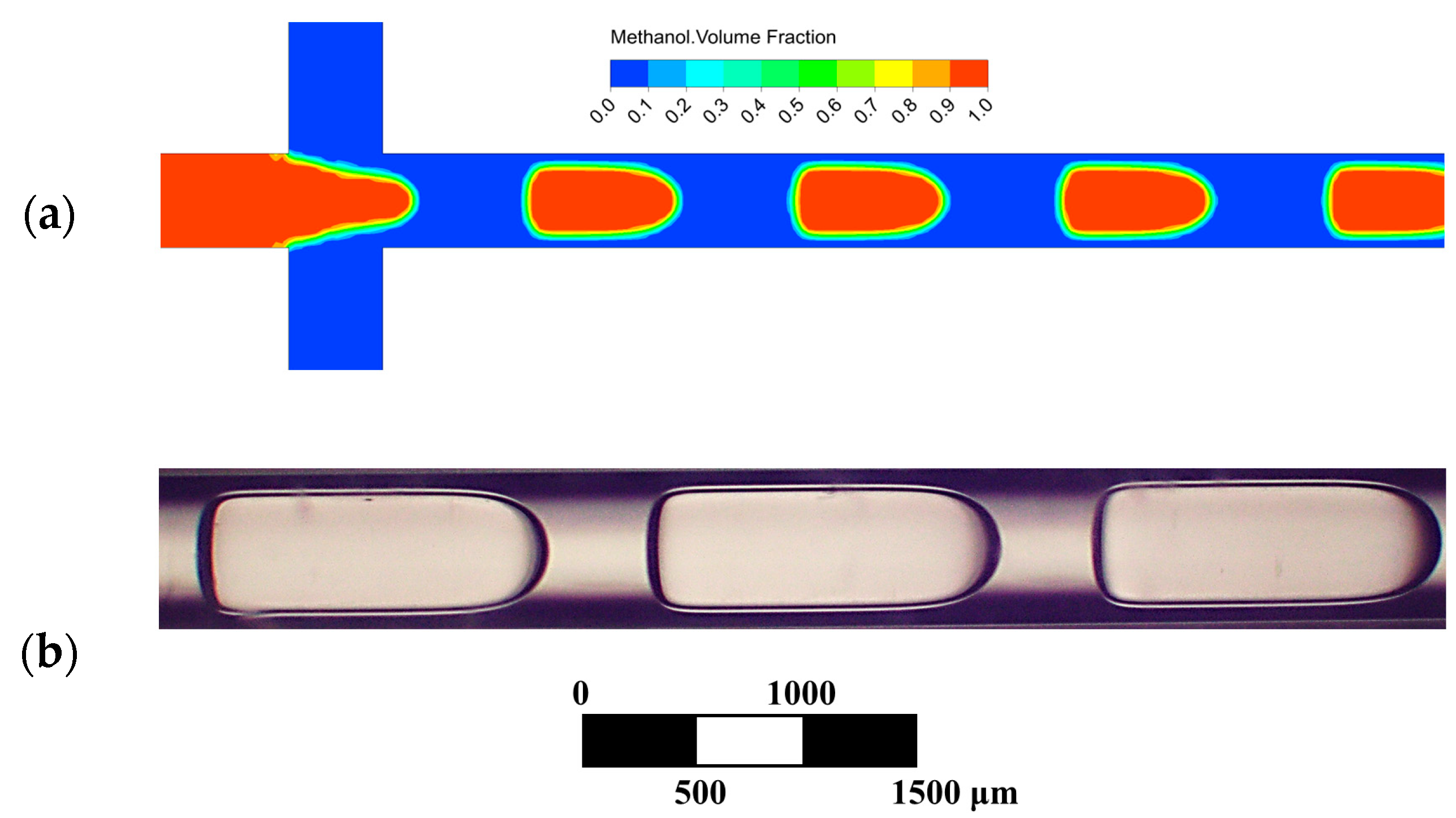
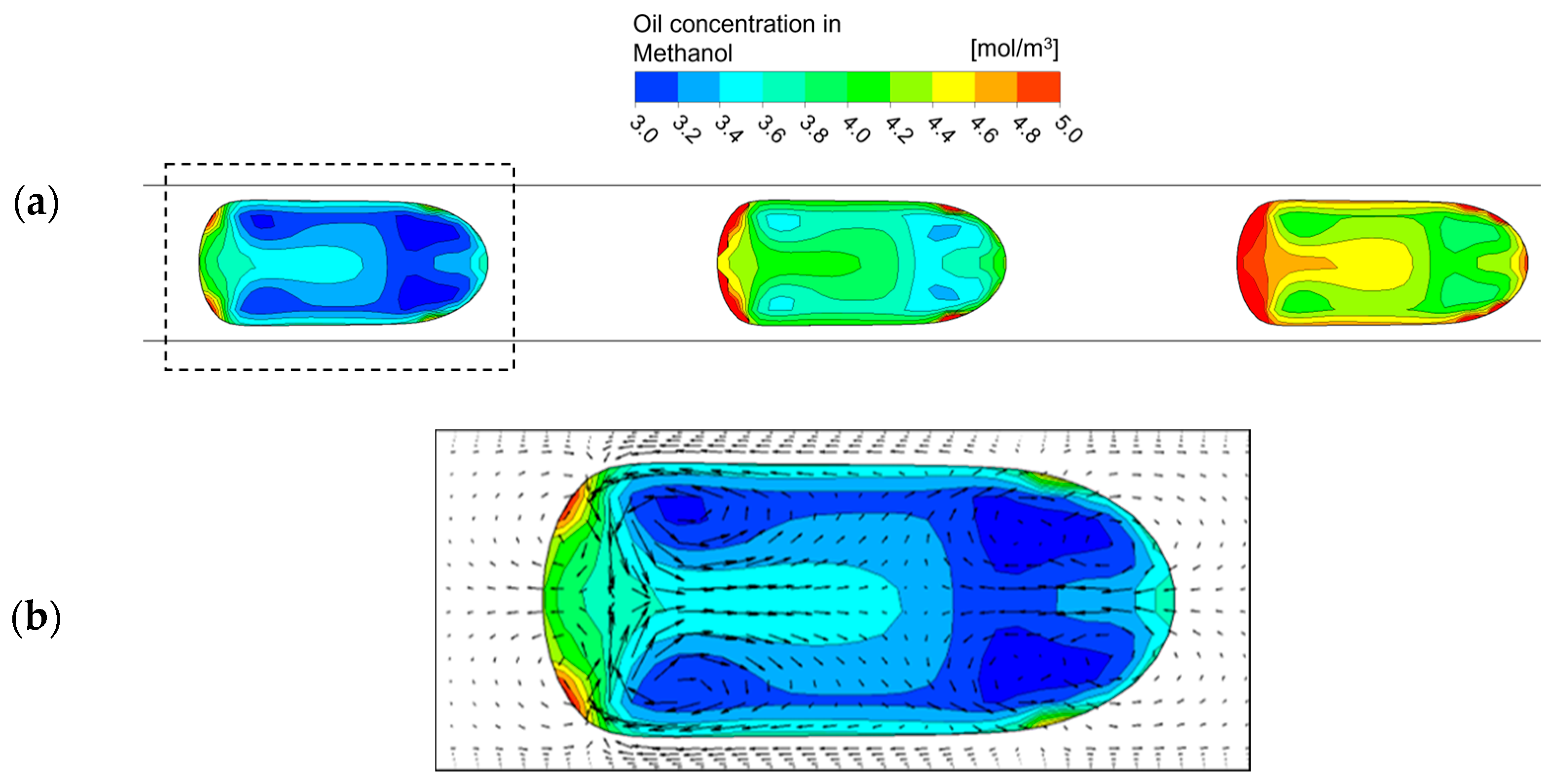

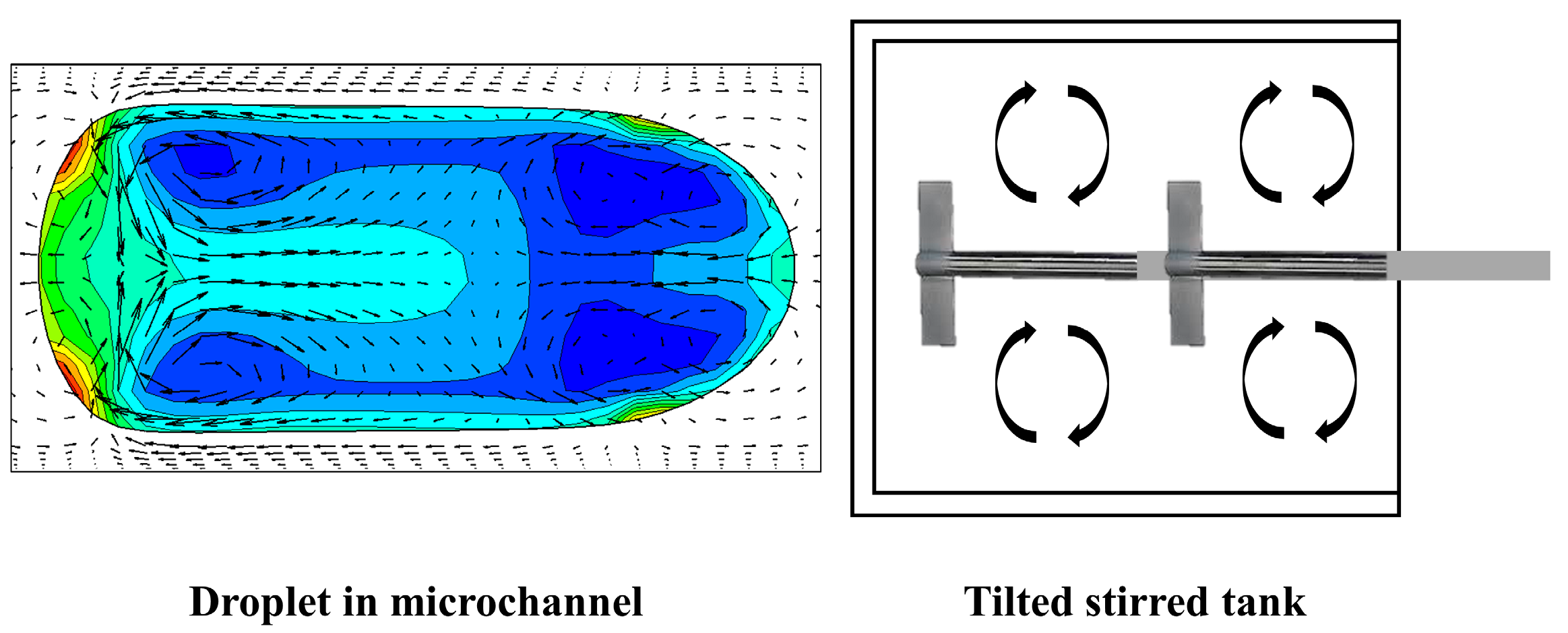


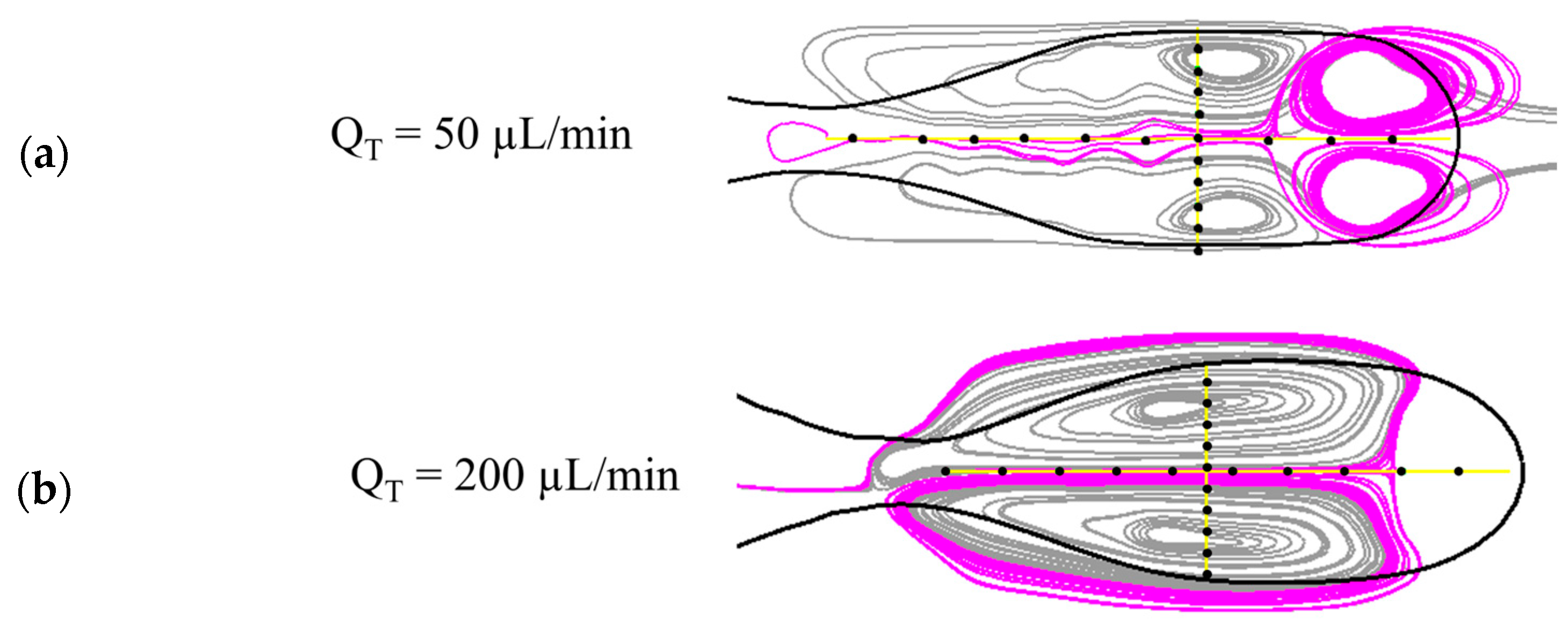

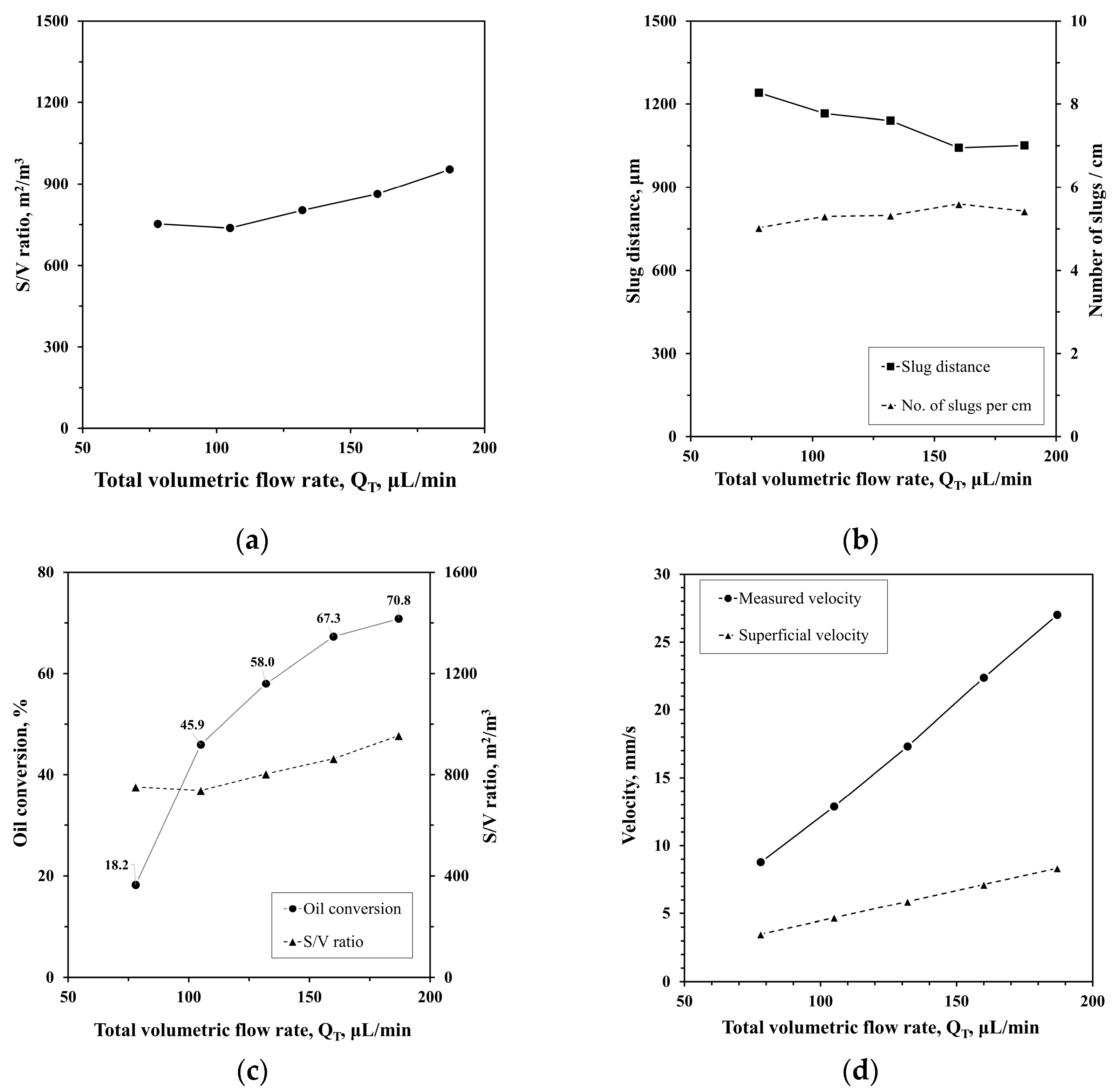
| Reactor Type | Temperature (°C) | Conversion (%) | Catalyst Type | Catalyst Conc. (wt%) | Residence Time (s) | Alcohol-to-Oil Ratio | Reference |
|---|---|---|---|---|---|---|---|
| Batch | 600 | 99.0 | CH3OK | 1.0 | 1800 | 6.0 | [9] |
| Batch | 62 | 89.0 | NaOH | 0.9 | 7200 | 7.0 | [10] |
| Batch | 65 | 91.0 | NaOH | 0.7 | 3600 | 8.0 | [11] |
| Batch | 30 | 99.3 | KOH | 1.0 | 1800 | 12.0 | [12] |
| Batch | 57 | 97.6 | KOH | 1.1 | 6780 | 5.0 | [13] |
| Microchannel | 25 | 98.6 | KOH | 5.0 | 40 | 7.6 | [8] |
| Microchannel | 60 | 97.9 | NaOH | 1.0 | 5 | 9.0 | [14] |
| Microchannel | 60 | 93.3 | KOH | 1.1 | 84 | 7.0 | [15] |
| Microchannel | 64 | 97.2 | KOH | 4.0 | 85 | 2.0 | [16] |
| Microchannel | 45 | 94.1 | NaOH | 1.0 | 90 | 8.0 | [17] |
| Parameters | Palm Oil | Methanol |
|---|---|---|
| Density, ρ [kg m−3] | 909.15 | 785 |
| Dynamic viscosity, μ [mPa s] | 69.1 | 0.5496 |
| Interfacial tension, γ [mN m−1] (between palm oil and methanol) | 3.27 | |
| Title 1 Total Volumetric Flow Rate, QT [μL/min] | Average Slug Formation Time [s] | Oil Concentration, CF [mol/m3] |
|---|---|---|
| 25 | 3.00 | 4.99 |
| 50 | 1.14 | 1.65 |
| 100 | 0.44 | 0.89 |
| 150 | 0.52 | 0.65 |
| 200 | 0.17 | 0.54 |
| Total Volumetric Flow Rate, QT (μL min−1) | Mass Transfer Rate (mol m−3 s−1) |
|---|---|
| 25 | 0.505 |
| 50 | 0.788 |
| 100 | 1.220 |
| 150 | 1.422 |
| 200 | 1.761 |
| Total Volumetric Flow Rate, QT (μL/min) | Moving Mass-Transfer Rate, kM (mol/m3 s) | Forming Mass-Transfer Rate, kF (mol/m3 s) | Mass-Transfer Contribution (%) |
|---|---|---|---|
| 25 | 0.505 | 1.66 | 34.1 |
| 50 | 0.788 | 1.44 | 20.5 |
| 100 | 1.220 | 2.00 | 14.6 |
| 150 | 1.422 | 2.53 | 12.4 |
| 200 | 1.761 | 3.19 | 12.3 |
| Channel Length, L [cm] | Total Volumetric Flow Rate, QTotal [µL/min] |
|---|---|
| 50 | 78 |
| 75 | 105 |
| 100 | 132 |
| 125 | 160 |
| 150 | 187 |
| Application | Multiphase System | Reference |
|---|---|---|
| Neutralization reaction | Acetic acid and sodium hydroxide in n-hexane mixture | [20] |
| Extraction | Water and toluene-acetic acid mixture | [32] |
| Mass-transfer simulation | Air and water | [21] |
| Reaction | N-butyl-formate and sodium hydroxide in water mixture | [33] |
Disclaimer/Publisher’s Note: The statements, opinions and data contained in all publications are solely those of the individual author(s) and contributor(s) and not of MDPI and/or the editor(s). MDPI and/or the editor(s) disclaim responsibility for any injury to people or property resulting from any ideas, methods, instructions or products referred to in the content. |
© 2023 by the authors. Licensee MDPI, Basel, Switzerland. This article is an open access article distributed under the terms and conditions of the Creative Commons Attribution (CC BY) license (https://creativecommons.org/licenses/by/4.0/).
Share and Cite
Mohd Laziz, A.; Chuah, C.Y.; Denecke, J.; Bilad, M.R.; Ku Shaari, K.Z. Investigation of Mass-Transfer Performance for Biodiesel Reaction in Microchannel Reactor using Volume-of-Fluid with Species-Transport Model. Sustainability 2023, 15, 6148. https://doi.org/10.3390/su15076148
Mohd Laziz A, Chuah CY, Denecke J, Bilad MR, Ku Shaari KZ. Investigation of Mass-Transfer Performance for Biodiesel Reaction in Microchannel Reactor using Volume-of-Fluid with Species-Transport Model. Sustainability. 2023; 15(7):6148. https://doi.org/10.3390/su15076148
Chicago/Turabian StyleMohd Laziz, Afiq, Chong Yang Chuah, Jens Denecke, Muhammad Roil Bilad, and Ku Zilati Ku Shaari. 2023. "Investigation of Mass-Transfer Performance for Biodiesel Reaction in Microchannel Reactor using Volume-of-Fluid with Species-Transport Model" Sustainability 15, no. 7: 6148. https://doi.org/10.3390/su15076148








